29th: 1 Swift over Treshnish wood, 2 Bullfinches (incl 1 adult male) outside our garden.
2 adult Black-headed Gulls and at least 1 Common Tern off Treshnish boathouse.
28th: Today I found further indications that the male Golden Eagle is in trouble. I saw him on the ground above Treshnish House (one level above the lochan).
He couldn't take off and it took him over half an hour to walk all the way to near the top of the Cruachan when he was able to take off.
The wind was coming from the south so it seems that he had to get into the wind before he could fly. Presumably he had walked even further before I first saw him and presumably from the point of an an attack by him or the female.
An hour and a quarter later I saw the female flying on the west side of the Cruachan and twenty minutes later she flew to the area where I had last seen the male.
Two minutes later they were both flying around together in all their usual majesty and flew together to the same spot where the male appeared from.
It is possible that this is not the female as the nape does not look very golden but I can't imagine what else it could be.
Yesterday I heard than a fledgling from another nearby Golden Eagle pair has been fitted with a satellite transmitter. It hasn't been done by the RSPB so I doubt that its movements will be available on GoogleEarth but hopefully we will get to hear something of its movements.
This is the Scottish project. and more here and their blog which will hopefully incorporate the Mull bird(s). Details on the Cairngorm satellite tagged birds.
1 male Hen Harrier on south side of Cruachan and a Short-eared Owl flushed from the ground, Blackcap still singing in Treshnish wood and 1 Cuckoo by Ensay Burn cattle-grid.
Families of Kestrels seem to be everywhere.
27th: There has been some views aired recently on Mull that the Puffin numbers on the Treshnish Isles are declining due to White-tailed Eagle predation. I am sure White-tailed Eagles take some Puffins and so will many other raptors including gulls and skuas but so far there is no evidence that the overall numbers are being reduced by White-tailed Eagles. Predator-prey relationships is one of the most studied areas of ecology and many studies have shown that in the wild predators and prey will reach a natural balance.
But the first question is: are Puffin or other seabird numbers declining?
Sticking to the available evidence, the Treshnish Isles Auk Ringing Group has been counting the birds on the Treshnish Isles since 1971.
Here is a chart of 8 of the seabird species since 1994. The maps are from the TIARG 2009 report and I have added the data from 2010 (2011 is not available yet and they are probably out there right now doing this years ringing).
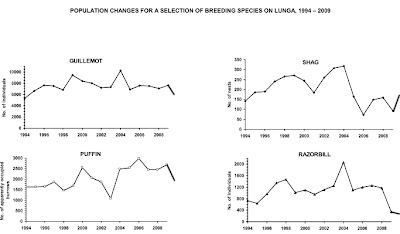
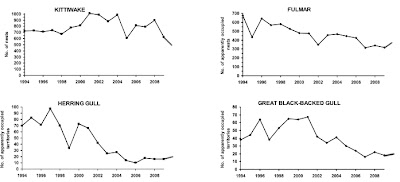
2010 was a bad year for auks although Shags, Fulmars and the 2 gull species had an increase on the previous year. Overall the numbers of Puffins and Guillemots have been good in recent years and even the Razorbill graph which has declined since 1994 is fairly stable compared to 1971 when TIARG figures show that the 2010 figures were equal to 1974 and 1986.
Fulmars once bred in much higher numbers at Treshnish and Caliach and again some local opinion blames White-tailed Eagles. I have no doubt they do predate Fulmars but there is no evidence that they are the sole cause of a decline. In 2010 the numbers on the Treshnish Isles rose by 5% from the previous year which does not support the theory of a White-tailed Eagle driven decrease!
Even so since 1994 overall numbers of Fulmars have declined by 4%, as they have declined throughout the UK. This needs to be taken into context. Breeding did not occur in Argyll AT ALL until 1924. Breeding first occurred on Iona and Staffa in 1947! They were seen prospecting for sites for the first time at Treshnish and Caliach in 1932 & 1934 (but they did NOT breed).
Kittiwakes also used to breed on Gribun in the 1890s, luckily (or unluckily) the White-tailed Eagle was virtually extinct at that time so can hardly be blamed for that loss. Between 1968-70 and 1985-87 Kittiwake numbers increased by 143% and no one knows why. Even though there are these fluctuations the numbers on the Treshnish Isles are slightly worrying if the decline continues. The 2010 number of 476 nests was the lowest since 1994 and the the second lowest since counts began in 1971 (the lowest was 336 in 1986).
I eagerly await the publication of the TIARG 2011 report. There are so many factors which can cause population changes and fluctuations (weather, climate change, fish stocks, disease, pollution, other predators, human disturbance, dogs) so jumping to conclusions without solid evidence is not going to help.
26th: Carolyne saw 2 Mountain Hares below Treshnish House.
Finally got around to identifying micros from the visit of eminent moth experts Roy Leverton and Mark Young on the 17th. Roy is author of Enjoying Moths and his expertise at identifying macro-moths from photographs is shared so generously on the Scottish Moths Group. Mark is author of The Natural History of Moths and is one of the leading micro-moth experts in Britain.
Aethes piercei was already mentioned as new for Mull and after they left I found Epinotia subocellana
Another micro-moth which Mark pointed out is one I have trapped several times before but never seen as a caterpillar; Depressaria daucella which feeds on Hemlock Water-dropwort.
A new micro-moth for Treshnish was Cydia ulicetana, this is the Scottish form.
25th: This Tree Pipit near the Ensay Burn cattle-grid is a new breeding species for Treshnish. It was alarmed so must have had young or a nest nearby.
But I am having grave doubts about the possibility of the Barn Owls breeding. I haven't heard of anyone seeing either of them for about 2 weeks and I haven't seen the pale bird since the 3rd. At first I thought it must be because the pale bird was the female which had disappeared to sit on eggs. Now I have found out that the statement in the Raptors monitoring & surveying book I mentioned is wrong (thanks Graeme). Females are not paler than males and it is usually the opposite so the very pale bird was probably a male but they cannot be reliably sexed in the field. This has a some good tips.
This Lapwing near Rubha nan Oirean, Calgary bay was obviously breeding.
1 probable Whimbrel and 1 Mountain Hare at Rubha nan Oirean.
Went to north side of Calgary bay to look for new sites for Slender Scotch Burnet. I didn't find any but I did count 400 Transparent Burnets just in the Rubha nan Oirean area alone.
I have counted over 1,000 in the last fortnight along the north side of the bay and I have not even looked at the heathery slopes above the raised beach except at Inivea.
24th: The Common Gulls in the colony gets alarmed every time a Buzzard flies over and today I could see why. Within a minute of diving into the colony a Buzzard was chased out but it already had what I am pretty sure was a bird in its talons. I am not sure it was a Common Gull chick though as it appeared to be very dark. I tried to see where the Buzzard landed but couldn't find it. If this happens every day there would be no chicks left as there are no more than 20 pairs, so presumably I witnessed the rare event of a successful attack.
Interestingly much later a female Hen Harrier flew over Treshnish wood without creating any alarm at all.
I went to look for the old male Golden Eagle. I saw a Golden Eagle very soon on Cruachan Treshnish but I only caught a glimpse of part of a wing and soon after a distant soaring Golden Eagle (photo showed it to be the female). Not long after that I actually walked right under one on a small cliff. I heard the rush of enormous wings as the nagzul flew over my head and was gone - to quick to see any detail (perhaps nagzul should only apply to sea-eagles but when an eagle is this close it applies no matter which species). Kicking myself for not seeing the eagle before it saw me, I walked in the direction it flew (above Achnachaoil near where I saw it on the 18th). I found a roost area and a feather and later on the Common Gulls showed me a Golden Eagle on Cruachan Treshnish. Again I couldn't see which one it was (but photos showed it to be the female).
Heading back towards Treshnish a Common Gull showed me the old male sitting on an outcrop.
I really wanted to see if he could fly properly so I tried to get close. When I got to where I thought he was I couldn't see him. A Common Gull appeared to be diving at me and I thought 'he must be right here' and sure enough there he was just a few feet away.
The camera alerted him and he was off. Yes, he could fly and from the first view he looks fine...
but a closer look shows what a state he is in.
I looked at where he was perched and there were 4 feathers. This could be favourite roost and so these feathers could have been shed over several days but he gives the impression that he is dropping feathers by the minute. You can see another feather being shed.
I know I am anthropomorphising but it it is quite upsetting to see.
1 Mountain Hare above Treshnish lochan (usually they are in the coastal fields). A few weeks ago I glanced through a wee booklet on Mull Hares by John Clare. In it he writes that there are both subspecies of the Mountain Hare on Mull, the Irish and Scottish. I wonder if he came to this conclusion from historical research or by field identification. Irish Hares are not supposed to turn white in the winter and certainly the Treshnish hares do become more white on the hind parts. If he is right then presumably there has been a high degree of hybridization unless they live in totally different habitats with no overlap zones.
This Bog Orchid is above Treshnish House (it is minute).
There was a Northern Eggar caterpillar on the moor above the cow-barn very close to where I found it last year.
22nd: In Treshnish wood: 3 Wood Pigeons (scarce at this time of year), Siskins, singing male Blackcap (also seen), Spotted Flycatcher,
adult Willow Warbler (not sure why this thumbnail looks so bad, if you click on the photo it is quite good, better than the Spotted Fly above)
with noisy fledglings.
Pretty battered Kestrel by our house.
21st: Leena saw an owl at dusk beside our house which we think was a Tawny Owl.
20th: 11 or 12 Swifts flying south over Treshnish Old Schoolhouse (my first of the year and I think only the second for Mull). I saw none last year so it was a welcome sight.
Looking at all my Swift records it is amazing at the consistency of its timing. The records fall into three distinct categories Spring, Summer and Autumn. Of the summer records there are duplicate records (from different years) on 25th June, 26th June and 30th June. All other dates have single records. Going by these statistics there should be more sightings in the coming days because I have 9 records from the period of 25th of June until 4th of July.
1 Chiffchaff heard singing from Treshnish Old Schoolhouse,Twite on north side of Calgary bay.
Before sunset a Short-eared Owl over Treshnish wood made a new window tick at Treshnish Old Schoolhouse. There didn't seem to be many surviving Eider ducklings off Calgary beach.
Whitethroats with food for chicks
1 Otter on north shore of Calgary bay.
I counted 500 Transparent Burnets along the cliffs up to the raised beach on north side of Calgary bay. Add that to the 160 at Inivea on the 13th and extrapolate those numbers to the heathery slope above the raised beach and I estimate there were probably at least 1000 Transparents and I did not even get as far as Rubha nan Oirean (the rocky point). I will try and go further on the next sunny day to try to find a Slender Scotch amongst them.
1 male Keeled Skimmer along the track on north side of Calgary bay (before the pier) NM36625148. I didn't have time to get a photo before it flew off. I thought I caught a glimpse of one on the 13th but was no more than a hunch as it also flew off quickly. I always only use real time photos but this is one from 2010 (25th June) taken on a boggy pool near East cottage. A superb dragonfly!
Thyme Broomrape looking very very at same spot as last year at Calgary.
19th: 1 adult yellow-tagged White-tailed Eagle over Crackaig and 2 Red-throated Divers flying from Beinn Reudle towards Treshnish House.
At least 2 Short-eared Owls. A pair were perched near the nest site from last year after 1 adult performed the wing clapping display at the other. Soon afterwards one brought a small rodent to the nest. In the split second between these 2 shots the prey was transferred from the claws to the mouth. It had to fight off a pair of Hooded Crows for several minutes before being able to deliver it to the young.
About 6 Transparent Burnets at Crackaig.
A bee and Common Blue share a flower of Sherard's Downy-rose .
Fragrant Agrimony/Agrimony at Lòn Reudle
18th: I was watching some alarmed young Kestrels on the cliffs to south of the cairn above Port Haunn. I was puzzled as to what was the problem or whether they were just playing. After a while I got up to go and saw, only about 15m away, the old white-headed Golden Eagle. He seemed unable to fly any distance although perhaps he can fly when there is a wind. I did see him fly short distnaces but it was always out of view so I didn't actually see how he flew. This obvious weakness explains why there have been recent reports of him trying to lift a weeks old lamb. I think he is desperate and probably not going to live long. It is sad but new blood is needed as the pair has not been very productive in the last few years. If he is as old as I think he is, he must have helped bring a lot of Golden Eagles into the world.
I saw the female Golden Eagle soaring above Cruachan Treshnish an hour and a half earlier.
Red-throated Diver heard in the air from below Treshnish House. A Chiffchaff was heard singing from Treshnish Old Schoolhouse. Even though there is no proof of breeding of Chiffchaff, for my personal records I am going to claim this as a the first breeding record at Treshnish. This year singing has been heard throughout the breeding period for the first time. Bullfinches heard in Treshnish wood, 3 Siskins in Treshnish wood and a Spotted Flycatcher by the cattlegrid near the nissen hut beside Treshnish wood.
Grayling at Crackaig and Meadow Brown at Haunn.
17th: 2 Red-throated Divers flew south over Treshnish wood, 4 Greylags flying northeast over Haunn.
There were at least 3 pairs of Fulmars on the cliffs on the south side of Treshnish Point.
I am not sure who they have appropriated this nest from because I don't think a Fulmars nest is built up like this.
This is a pair on the ledge where I saw a pair mating last year.
The Linnets at East cottage, Haunn have fledged young. The male is still singing away,
the female
and young
I have just heard that Carolyne heard a Quail in evening of the 12th at Haunn and that someone else heard it in the afternoon.
Last year heard I heard one on 18th June and in 2009 a bird was calling for 3 weeks from 31st May until 21st June.
These 2 Large Red Damselflies are trying to make the mating wheel but one looks like it has lost part of its abdomen.
Common Blue.
Meadow Brown at Treshnish point. This Grass Rivulet in Black Park was only my second record (the first being on one day earlier in 2010).
Andy Kirkham also found 1 just over the fence west of Haunn field.
We had a visit from top Lepidopterists, Roy Leverton and Mark Young who are hoping too see a Treshnish speciality, The Grey. so far they have had no luck but who showed us some micro-moths. This is Aethes piercei a new species for Mull I think.
Whilst waiting to see Barn Owls at Haunn, Leena found a Small-white Orchid on a new site close to the known site. Slowly, slowly we eventually found at least 15 new plants! There didn't use to be any on this new mound.
14th: Went to Sunipol to look for Pyramidal Orchid which had been seen there in 1968 (when the road was just a track). I couldn't find it so looked for Slender Scotch Burnet, Didn't find any but did find 5 Transparent Burnets below Sunipol as well as Small Tortoishell, Small Pearl-bordered Fritillary
and Dark Green Fritillary.
After a couple of false leads and with the help of several people, I have been able find out about the Red Kite I saw at Treshnish on the 26th. It was a bird released from the Lake District introduction project at Grizedale Forest (home to Andy Goldsworthy sculptures) on 8th August 2011. It was originally taken from a nest in Northamptonshire. You can read more about it here.
As of April 2011 the furthest one of the birds was known to have travelled was 120km into Scotland. The Treshnish bird must have more than doubled that. I wonder if it will find the Argaty birds?
Only one month after the original release in 2010 a bird was shot, read about it here.
13th: Lapwings and Curlews behaving as though they have chicks on right side of Sunipol road to west of Langamull forest, Spotted Flycatcher at Calgary (NM3751).
Stonechat scolding me.
Went to look for new Slender Scotch Burnet sites. The north side of Calgary bay looks promising so I tried there. I only got as far a Inivea because there were so many burnets to look at. I counted 160+ Transparent Burnets in the surrounding area as well as smaller numbers of Six-spot Burnet but no Slender Scotch. I have seen Transparents in this area before but this time I looked a little further afield and in better habitat. There have been large numbers like this at Treshnish in previous years so I will check Treshnish within the next few days. Here are 2 mating.
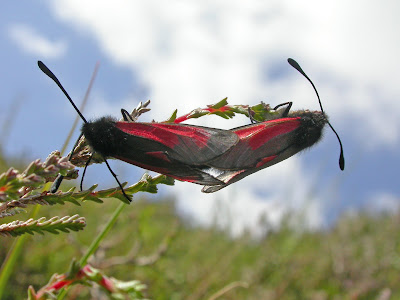
I think this one must be an aberration
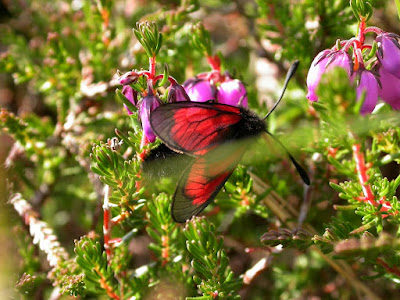
At Inivea there was also a faded Clouded Buff
and a Treble-bar. I have only caught this latter moth twice before (both in 2007 when one came to our window).
When I got home I saw there was a Six-spot Burnet caterpillar in the frame
There were at least 2 Large Heaths at Inivea (my first of the year - a fairly local species on Mull - not yet recorded at Treshnish)
as well as 2+ Common Blues, 2+ Small Heaths, 3+ Small Pearl-bordered Fritillaries and 2+ Dark Green Fritillaries.
My first Meadow Brown of the the year at Dùn Mhadaidh, Langamull.
Female/immature Common Darter at Dùn Mhadaidh, Langamull.
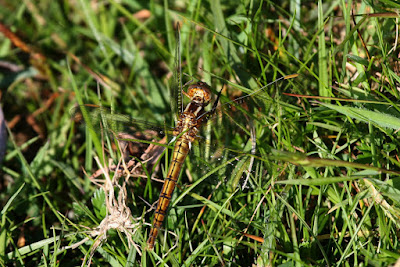
12th: Went to Langamull to see if the Scandinavian Rock Pipit was still present but I didn't see it.
Whilst looking for the pipit I caught a glimpse of a bird on the ground but as I approached the area it didn't fly. It turned out to be a Lapwing chick perfectly camouflaged.
We looked around the area where Leena first found a new site for the rare Slender Scotch Burnet last year. We had looked last week and found 11 moths but decided to see if there were more in the surrounding area. We had success and found 54 Slender Scotch (not including the original patch which had 11 last week) all in an an area about 200m from Leena's first site.

Close up showing rolled up proboscis
And this one shows proboscis unrolled.
and the pollen can be seen on the moths hairs
and if that doesn't show it, this should.
There are 6 in this photo alone.
We also found small numbers of the scarce Transparent Burnet
and a handful of the common Six-spot Burnet.
At Treshnish my first Common Darter of the year.
11th: At least 1 pair of Fulmars on the south side of Treshnish Point. I think I may have found a Buzzard nest at Treshnish point. I thought it was a Raven's nest but now my photos seem to show some white nestlings. The photo is very blurry so I may be imagining things. will check more closely later, Shelduck family with 6 ducklings off Ensay Burn mouth.
Heard a Chiffchaff singing in Black Park near the Hooded Crow nest. Not a place I would expect to hear one. I think they must have bred this year.
The leucistic Wheatear
has fledged young.
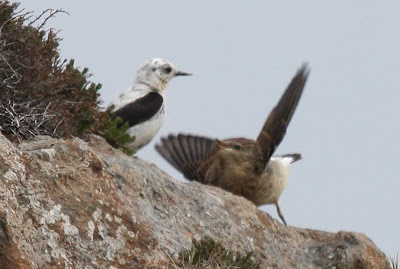
This looks like an interesting moth!
I think it is Pyrausta purpuralis a beautiful micro-moth.
The leucistic Wheatear must be a female because a male was seen feeding the same fledglings (bit of a surprise because she was always present and so how did she incubate her eggs?).
The young are normal.
This is a fledgling from another family.
This Meadow Pipit nest is right by the farm road to Haunn. I hope it doesn't get too disturbed by too many walkers like me.
I couldn't find the Frog Orchid I saw on the 3rd of June at Haunn but I did find 2 very small ones close by where I found 1 in 2010
and 1 larger one very close by. This is one of the rarest orchids at Treshnish and a Red Data species.
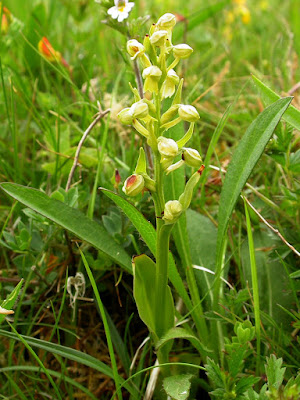
Some of the Small-white Orchids are fully flowering.
I couldn't find any Frog or Small-white Orchids in Black park (where last year I found 1 and 3 respectively).
I found loads of Smooth Sow-thistle below Haunn cottages
(another embarrassing admission that I've never managed to find it at Treshnish before) and although I have seen Marsh Arrowgrassat Treshnish I must have misses the large numbers which are at this same spot this year.
I don't know what this orchid is going to turn out to be, maybe a very large Small-white Orchid.

I did some research tried to find out why the female Barn Owl was flying around Treshnish House last week. In doing so I found I had made a slight error with the fledgling times which I quoted earlier (entry for 11th May) as 70-75 days which seemed so extreme. The book I got it from (Raptors a Field Guide to Survey and Monitoring) does give that fledging period in the summary table but reading the full text it is not strictly correct. The young CAN fly at 50-55 days but their feathers are not fully developed until 70-75. Presumably at 50-55 days they can only fly short distances.
Barn Owl facts (part 2)
1. Lay 2-9 eggs, occasionally up to 12
2. Only female incubates but she leaves the nest for 5-10 minutes about 3 times a day
3. Male begins feeding the female one month before laying and provides all her food during incubation and for 10 days after hatching.
4. Average food deliveries by male: 16 at laying, 8-11 during incubation and up to 14-16 at 30 days after hatching.
5. If the Haunn birds started incubating eggs on the 19th of May as I suspect, the eggs should hatch in about a week and we should start seeing the female regularly again at about the end of June. The young should be able to make short flights after about the 9th of August.
10th: 1 of the Oystercatcher pairs below Treshnish House is still sitting on eggs but the one near the boathouse must have hatched because today and on the 8th the adults are alarmed but there are no eggs, 2 Fulmars sitting on the breeding ledges on north side of Treshnish Point, 7 Greylags flew east over Haunn and 2 flew to Treshnish lochan at sunset. The Common Gulls at the colony must have chicks now (even a Buzzard passing over causes an almighty commotion).
Not the best shot but it appears to be feeding on aphids on this Goat Willow.
1 Otter to west of Treshnish boathouse.
I found a skull along the shore. I thought it must be an Otter but after looking on the internet I am pretty sure it is a domestic dog.
I went to survey the nearby Narrow and Broad-leaved Helleborine site. There were no Broad-leaved flowering and none of the Narrow-leaved have born fruit but I am pretty sure I found some new Narrow-leaved Helleborine plants. Totals: 5 post-flowering and 12 non-flowering Narrow-leaved Helleborine and 4 non-flowering Broad-leaved Helleborine. At Treshnish there was only 1 flowering Narrow-leaved Helleborine (which did not bare fruit) and 3 non-flowering Broad-leaved Helleborines.
The Narrow-leaved numbers are almost the same as last year (20 to 18) but the Broad-leaved are lower (11 to 7) but the latter is probably only a result of less effort and midges. The vegetative plants are not easy to see.
There are at least 25 Aspen trees on the east side of Ensay Burn mouth (embarrassing that I have only just noticed them!).
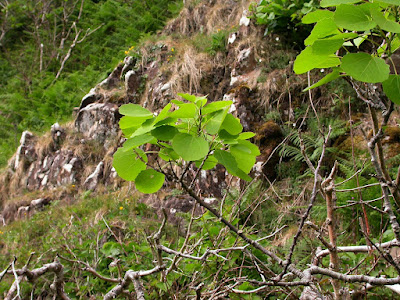
8th: Pair of Shelducks with 6 ducklings off shore below Treshnish House swam west to the west of the boathouse.
Presumably this is the same family Leena and I saw at Lainne Sgeir on the 6th. This is a good Dad. Apparently males don't often attend the chicks. This is also a good survival rate for the chicks. At this stage last year only 2 had survived.
1 male Hen Harrier at Treshnish Point (I only had a glimpse but I think it was not pale enough to be a full adult). Almighty noise at the common gull colony meant there was definitely a raptor attack but I didn't see the culprit. A noise that loud could only mean eagle or Peregrine. Peregrine is very rare here at this time of year so it was probably an eagle.
Kestrel.
1 Red Admiral at Treshnish steadings, my first Dark Green Fritillary of the year in field below Treshnish House as well as my first Silver Y (migrant moth).
At least 1 Thyme Broomrape emerging at Ensay Burn mouth.
7th: 1 House Martin over Treshnish wood, 2 Wood Pigeons flying into Treshnish wood.
6th: I was very surprised to find the Scandinavian Rock Pipit still at Langamull. I didn't have enough time stalking to get good photos.
Unfortunately no sign of the Arctic Terns which were attempting to nest last week but great to hear and see a Lapwing between Sunipol road and Langamull forest.
Pair of Shelducks with 6 ducklings at Lainne Sgeir, Calgary, 2 Greylag Geese flying from Treshnish lochan and 4 seen most days in fields below Ensay.
Tawny Owls heard at night from Treshnish Old Schoolhouse.
It seems to be a good year for Slender Scotch Burnets at Langamull.
We found at least 11 at a site where I usually only find one or two (often after hours of looking). At another site that Leena discovered last year there were at least 11 moths, the same as last year. We didn't look at the main colony.
There were may mating pairs.
We also found a couple of Transparent Burnets
but none of the common Six-spot Burnet which must come out later.
I saw a probable immature Keeled Skimmer at Calgary farmhouse but I didn't get a photo. [It looked quite brownish].
There was also a Large Red Damselfly just back from the Machair.
My first Early Marsh-orchid of the year at Langamull. One of my favourite plants.
5th: I have just found out that the yellow/white tagged #7 Red Kite I saw last week was not from the Chilterns (they didn't have a number 7 last year). It is possible that it is an orange/white tagged bird from the Lake District. I am awaiting identification.
Spent 3 or 4 hours watching from a distance a Golden Eagle nest area. Unfortunately I saw neither chick nor adults!
There is a Kestrel nest not far away which is quite low down and I was planning on erecting a hide. Unfortunately the young are already fledged so they are not close enough.
One was flying around quite freely. Last year the young were scrabbling about the nest site unable to fly on the 11th.
Wheatear recently fledged.
Pied Wagtail recently fledged.
This had me puzzled but I think it is just Wild Thyme in bud.
4th: 1 Great Skua at Treshnish boathouse.
Fledglings and eggs everywhere. Fledgling, Robins, Wrens, Great Tits, Meadow Pipits and Blackbirds. Eggs of Common Gull at the colony and agitated parent Common Sandpipers at the boathouse.
The Short-eared Owls were pretty quiet at 8pm
and after 9pm they just seemed to lounge around on fence posts. They must be either flying earlier or later or both. No sign of adults bringing food to young. There appeared to be at least 2 territories.
There were no Fulmars sitting on their ledges on the north side of Treshnish Point but at least 1 was flying around the cliffs.
Gannet.
1 Adder crossing the road through Black Park field. Luckily it didn't cross a couple of minutes earlier when 3 cars passed by.
Four-spotted Chaser at boathouse
Common Moon Jellyfish (Aurelia aurita) to west of boathouse
3rd: 2 Robin fledglings by Treshnish Old Schoolhouse.
At 11pm a pale Barn Owl flew in between the farm buildings at Treshnish. It was quite dark but I am almost certain it wasn't the dark male.
I wasn't expecting to see the female for a while yet. The last time she was seen was on the 19th or 20th of last month. According to the literature the female alone incubates the eggs which takes 30 days. After hatching she broods alone for 10 days and then starts hunting. So presuming she laid eggs on the 19th she shouldn't be hunting until about the 29th of June.
Arthur Brown saw 3 Swifts in the Reudle area. These are the first of the year for Mull.
I have posted a draft of scarce birds at Treshnish and environs. See previous post. It is not complete.
Found 1 Frog Orchid at Haunn.
This is a spot where I first found 3 plants on exactly the same date in 2009. I could only find 1 in 2010 and none last year so it was a pleasant surprise.
There is one other site nearby where I found 2 plants in 2009 and 1 in 2010. On Treshnish this is the rarest of the threatened plants.
Small-white Orchid another of the rare threatened plants at Treshnish is almost open.
Both these plants are extremely small.
This Heath Spotted-orchid has unusually heavily marked leaves.
I have to watch what this nearby orchid turns out to be. the leaves are almost black.
2nd: 1 Blackbird fledgling between Treshnish House and Old Schoolhouse.
Walking the dogs I kept above the rocky shoreline where I know there is an Oystercatcher on eggs. A few hundred metres away above the shore, sitting watching sea birds there were another pair of Oystercatchers on the shore so obviously there was another nest nearby. I decided to move on to allow them back on the eggs and as I got up I saw we were sitting just a few feet from the nest. Luckily the dogs are as useless as me.
1st: 1 (possible female) Golden Eagle on Cruachan Treshnish, 1 Common Tern off from Treshnish boathouse.
I read that butterflies number were down throughout the UK last year.
I have seen a handful of Small Pearl-bordered Fritillaries already this year which is more than for the whole of last year. Mull and particularly the west coast were hit by a storm in late May.
The white spots on the underside distinguish this from the rarer Pear-bordered Fritillary (not recorded on Mull).

